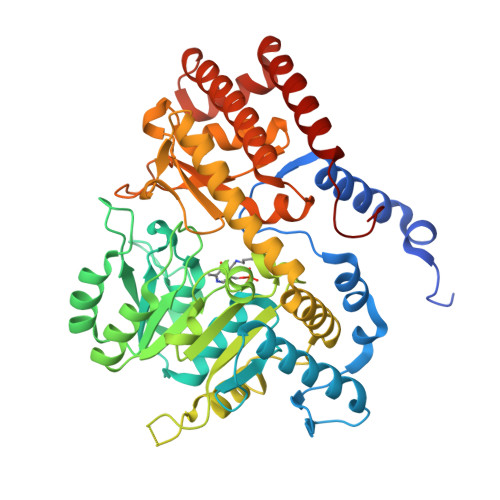How pyridoxal 5'-phosphate differentially regulates human cytosolic and mitochondrial serine hydroxymethyltransferase oligomeric state.
Giardina, G., Brunotti, P., Fiascarelli, A., Cicalini, A., Costa, M.G., Buckle, A.M., di Salvo, M.L., Giorgi, A., Marani, M., Paone, A., Rinaldo, S., Paiardini, A., Contestabile, R., Cutruzzola, F.(2015) FEBS J 282: 1225-1241
- PubMed: 25619277
- DOI: https://doi.org/10.1111/febs.13211
- Primary Citation of Related Structures:
4PVF - PubMed Abstract:
Adaptive metabolic reprogramming gives cancer cells a proliferative advantage. Tumour cells extensively use glycolysis to sustain anabolism and produce serine, which not only refuels the one-carbon units necessary for the synthesis of nucleotide precursors and for DNA methylation, but also affects the cellular redox homeostasis. Given its central role in serine metabolism, serine hydroxymethyltransferase (SHMT), a pyridoxal 5'-phosphate (PLP)-dependent enzyme, is an attractive target for tumour chemotherapy. In humans, the cytosolic isoform (SHMT1) and the mitochondrial isoform (SHMT2) have distinct cellular roles, but high sequence identity and comparable catalytic properties, which may complicate development of successful therapeutic strategies. Here, we investigated how binding of the cofactor PLP controls the oligomeric state of the human isoforms. The fact that eukaryotic SHMTs are tetrameric proteins while bacterial SHMTs function as dimers may suggest that the quaternary assembly in eukaryotes provides an advantage to fine-tune SHMT function and differentially regulate intertwined metabolic fluxes, and may provide a tool to address the specificity problem. We determined the crystal structure of SHMT2, and compared it to the apo-enzyme structure, showing that PLP binding triggers a disorder-to-order transition accompanied by a large rigid-body movement of the two cofactor-binding domains. Moreover, we demonstrated that SHMT1 exists in solution as a tetramer, both in the absence and presence of PLP, while SHMT2 undergoes a dimer-to-tetramer transition upon PLP binding. These findings indicate an unexpected structural difference between the two human SHMT isoforms, which opens new perspectives for understanding their differing behaviours, roles or regulation mechanisms in response to PLP availability in vivo.
- Dipartimento di Scienze Biochimiche 'A. Rossi Fanelli', Sapienza Università di Roma, Italy.
Organizational Affiliation:



















